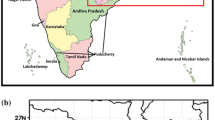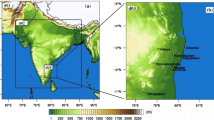Abstract
The timely prediction of thunderstorms (TS) is always a challenging task for operational and research community. The present study is aimed to address the credibility of the high grid-spacing and downscaling approach for improved simulation of TS. Fourteen TS are simulated with different domain configurations using weather research and forecasting (WRF) model. Two nested domains with 9–3 km (known as DD3), and 6–2 km (DD2), and 3 km single domain (SD3) are considered for simulations. Results indicate that the high-resolution DD2 has improved 2-m temperature (T2), 2-m relative humidity (RH2), and 10-m wind speed (WS10) at different stages of TS. The average mean error of T2 and RH2 in the DD2 experiment is 0.7 °C, − 6% during the mature stage, and 0.2 °C, − 4% at dissipating stage. The error in SD3 and DD3 is relatively higher (9–17% for T2 and 20–60% for RH2). Better horizontal and vertical representation of thermodynamic variables in DD2 run reinforces the atmosphere to initiate and intensify the convection in the right place. The DD2 could show slightly higher instability (convective available potential energy, CAPE, 3188 J kg−1) as compared with DD3 (3164 J kg−1) and SD3 (3020 J kg−1). The model is biased to simulate early TS activity. DD2 run could simulate the formation, mature and dissipation stages with fewer timing errors (− 1.35 h, − 1.5 h, and − 2.6 h, respectively) than other experiments. The critical success index of the DD2 run is higher for all the rainfall thresholds; however, it is more than 0.2 up to 2.5 mm h−1. The results highlight that high resolution nested configuration yields better simulation skills than the single domain configuration.










Similar content being viewed by others
Availability of data and material
The data that support the findings of this study are available from the corresponding author upon reasonable request.
Code availability
The numerical modeling code is freely available and accessible.
References
Basu GC, Mondal DK (2002) A forecasting aspect of thundersquall over Calcutta and its parameterisation during pre-monsoon season. Mausam 53(3):271–280
Benestad RE, Haugen JE (2007) On complex extremes: flood hazards and combined high spring-time precipitation and temperature in Norway. Clim Chang 85(3):381–406
Copernicus Climate Change Service (C3S) (2017) ERA5: fifth generation of ECMWF atmospheric reanalyses of the global climate. Copernicus Climate Change Service Climate Data Store (CDS), 2018/12. https://cds.climate.copernicus.eu/cdsapp#!/home
Das S, Sarkar A, Mohanty UC, Tyagi A, Sikka DR, Joseph PV, Sonam K (2014) The SAARC STORM: a coordinated field experiment on severe thunderstorm observations and regional modeling over the South Asian Region. Bull Am Meteor Soc 95(4):603–617
Dhawan VB, Tyagi A, Bansal MC (2008) Forecasting of thunderstorms in pre-monsoon season over northwest India. Mausam 59(4):433–444
Done J, Davis CA, Weisman M (2004) The next generation of NWP: explicit forecasts of convection using the Weather Research and Forecasting (WRF) model. Atmos Sci Lett 5(6):110–117
George JJ (1960) Weather forecasting for aeronautics. Academic Press, San Diego, p 411
Ghosh A, Lohar D, Das J (2008) Initiation of Nor’wester in relation to mid-upper and low-level water vapor patterns on METEOSAT-5 images. Atmos Res 87(2):116–135
Giorgi F, Hewitson B, Christensen JH, Hulme M, et al (2001) Regional climate information – evaluation and projections. In: Houghton JT et al (eds) Chapter 10 of Climate change 2001: The Scientific Basis, Contribution of WGI to the Third Assessment Report of IPCC. Cambridge University Press, Cambridge, UK
Hou AY, Kakar RK, Neeck S, Azarbarzin AA, Kummerow CD, Kojima M, Iguchi T (2014) The global precipitation measurement mission. Bull Am Meteor Soc 95(5):701–722
Kaur M, Krishna RPM, Joseph S, Dey A, Mandal R, Chattopadhyay R, Abhilash S (2020) Dynamical downscaling of a multimodel ensemble prediction system: Application to tropical cyclones. Atmos Sci Lett 21(8):e971
Kumar B, Chattopadhyay R, Singh M, Chaudhari N, Kodari K, Barve A (2021) Deep learning–based downscaling of summer monsoon rainfall data over Indian region. Theoret Appl Climatol 143(3):1145–1156
Leena PP, Pandithurai G, Gayatri K, Murugavel P, Ruchith RD, Sakharam S, Prabhakaran T (2019) Analysing the characteristic features of a pre-monsoon thunderstorm event over Pune, India, using ground-based observations and WRF model. J Earth Syst Sci 128(4):108
Litta AJ, Mohanty UC (2008) Simulation of a severe thunderstorm event during the field experiment of STORM programme 2006, using WRF—NMM model. Curr Sci (00113891) 95(2)
Litta AJ, Mohanty UC, Idicula SM (2012) The diagnosis of severe thunderstorms with high-resolution WRF model. J Earth Syst Sci 121(2):297–316
Liu C, Moncrieff MW (2007) Sensitivity of cloud-resolving simulations of warm-season convection to cloud microphysics parameterizations. Mon Weather Rev 135(8):2854–2868
May PT, Rajopadhyaya DK (1999) Vertical velocity characteristics of deep convection over Darwin, Australia. Mon Weather Rev 127(6):1056–1071
Miller R (1972) Notes on analysis and severe storm forecasting procedures of the Air Force Global Weather Central. Technical Report 200 (Rev.), AWS, U.S. Air Force (Headquarters, AWS, Scott AFB, IL62225), 102 pp
Moncrieff MW, Miller MJ (1976) The dynamics and simulation of tropical cumulonimbus and squall lines. Q J R Meteorol Soc 102(432):373–394
Mukhopadhyay P, Sanjay J, Singh SS (2003) Objective forecast of thundery/nonthundery days using conventional indices over three northeast Indian stations. Mausam 54(4):867–880
Mukhopadhyay P, Mahakur M, Singh HAK (2009) The interaction of large scale and mesoscale environment leading to formation of intense thunderstorms over Kolkata Part I: Doppler radar and satellite observations. J Earth Syst Sci 118(5):441
Osuri KK, Nadimpalli R, Mohanty UC, Chen F, Rajeevan M, Niyogi D (2017) Improved prediction of severe thunderstorms over the Indian Monsoon region using high-resolution soil moisture and temperature initialization. Sci Rep 7(1):1–12
Osuri KK, Ankur K, Nadimpalli R, Busireddy NKR (2020) Error characterization of ARW model in Forecasting tropical cyclone rainfall over North Indian Ocean. J Hydrol 590:125433
Prasad SK, Mohanty UC, Routray A, Osuri KK, Ramakrishna SSVS, Niyogi D (2014) Impact of Doppler weather radar data on thunderstorm simulation during STORM pilot phase—2009. Nat Hazards 74(3):1403–1427
Rajasekhar M, Sreeshna T, Rajeevan M, Ramakrishna SSVS (2016) Prediction of severe thunderstorms over Sriharikota Island by using the WRF-ARW operational model. In: Remote sensing and modeling of the atmosphere, oceans, and interactions VI, vol 9882. International Society for Optics and Photonics, p 988214
Sarkar A, Das S, Dutta D (2019) Computation of skill of a mesoscale model in forecasting thunderstorm using radar reflectivity. Model Syst Environ 5(2):443–454
Schaefer JT (1990) The critical success index as an indicator of warning skill. Weather Forecast 5(4):570–575
Soares PM, Cardoso RM, Miranda PM, de Medeiros J, Belo-Pereira M, Espirito-Santo F (2012) WRF high resolution dynamical downscaling of ERA-Interim for Portugal. Clim Dyn 39(9–10):2497–2522
Tyagi A (2007) Thunderstorm climatology over Indian region. Mausam 58(2):189
Tyagi B, Krishna VN, Satyanarayana ANV (2011) Study of thermodynamic indices in forecasting pre-monsoon thunderstorms over Kolkata during STORM pilot phase 2006–2008. Nat Hazards 56(3):681–698
Xue Y, Janjic Z, Dudhia J, Vasic R, De Sales F (2014) A review on regional dynamical downscaling in intraseasonal to seasonal simulation/prediction and major factors that affect downscaling ability. Atmos Res 147:68–85
Wang SC, Huang SX, Li Y (2006) Sensitive numerical simulation and analysis of rainstorm using nested WRF model. J Hydrodyn 18(5):578–586
Williams E, Renno N (1993) An analysis of the conditional instability of the tropical atmosphere. Mon Weather Rev 121(1):21–36
Acknowledgements
The authors acknowledge the partial financial support from Earth System Science Organization, Ministry of Earth Sciences (MoES), Govt. of India. This work is part of the THUMP Project (No.MoES/16/09/2018-RDEAS-THUMP-7) supported by MoES. The authors also acknowledge the European center for Medium Range Weather Forecasts (ECMWF), National Aeronautical and Space Administration (NASA), Indian Space Research Organization (ISRO) and Iowa state university of Science and Technology for ERA5, GPM, INSAT-3D, and METAR data sets, respectively, to carry out this study. IMD is acknowledged for making storm reports available.
Funding
No funding information is available.
Author information
Authors and Affiliations
Contributions
Kumari Priya contributed to model simulations, methodology, data preparation, analysis, writing, reviewing and editing. Raghu Nadimpalli contributed to analysis, writing, reviewing and editing. Krishna K Osuri contributed to conceptualization, methodology, supervision, analysis, review and editing.
Corresponding author
Ethics declarations
Conflict of interest
The authors declare that they have no known competing interests for this publication.
Additional information
Publisher's Note
Springer Nature remains neutral with regard to jurisdictional claims in published maps and institutional affiliations.
Rights and permissions
About this article
Cite this article
Priya, K., Nadimpalli, R. & Osuri, K.K. Do increasing horizontal resolution and downscaling approaches produce a skillful thunderstorm forecast?. Nat Hazards 109, 1655–1674 (2021). https://doi.org/10.1007/s11069-021-04893-5
Received:
Accepted:
Published:
Issue Date:
DOI: https://doi.org/10.1007/s11069-021-04893-5




